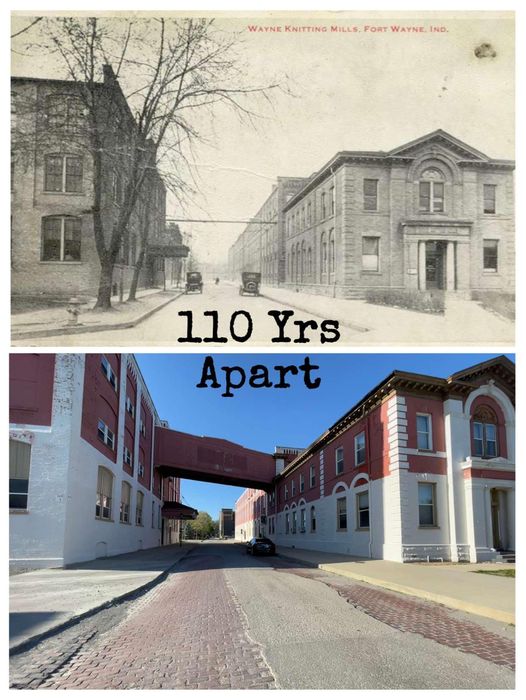
free genealogy since 1996
Allen County, Indiana Genealogy
Places in Allen County, Indiana
Wayne Knitting Mills
Street View photo from Google maps on Watkins Street near Boone Street from 2011
is a similar location to the 2022 photo of the new Historic Wayne Knitting Mills Park Nebraska Neighborhood Association sign.
October 14, 2022 post by Nebraska Neighborhood Association, Fort Wayne, Indiana 46808 on Facebook
Showing the new Historic Wayne Knitting Mills Park sign (more on Google) .
On Growth Avenue in the Nebraska Neighborhood. The sprawling hosiery factory site was started by Theordore F. Thieme as Thieme Brothers Knitting Mills circa 1875, and incorporated as Wayne Knitting Mills in 1891. By 1905, it employed approximately 1,100 workers and became the largest maker of knitted hosiery in the world, spurring residential development in the area. The business thrived well into the 1900s. Today, the mill complex consists of five buildings.
- Wayne Knitting Mills photos and Wayne Knitting Mills collection at the Allen County Public Library Digital Collections at the Allen County Public Library.
-
June 26, 2023 post by Genealogy Center on Facebook:
Wayne Knitting Mills, located in Fort Wayne, Indiana, was America's largest producer of silk hosiery from 1892 to 1960.
This collection is comprised of company’s two publications: Wayne Knitting Mills News Letter (1952-1954) and Wayne Knit Rav-Lings (1913). Posting these newsletters is a cooperative project of Fort Wayne’s History Center and The Genealogy Center.
View them here: http://contentdm.acpl.lib.in.us/digital/collection/WKM
1914-2024 then and now photo posted April 21, 2024 on True Fort Wayne Indiana History on Facebook.
Top photo is labeled Wayne Knitting Mills, Fort Wayne, IN. FWFV00654A of a postcard dated April 30, 1930 from Wayne Knitting Mills search results at the Allen County Public Library Digital Collections at the Allen County Public Library . One comment says:In the late 1940's the Ward Aluminum Company began operation at that site and began their aluminum foundry and manufacturing facility including all buildings at that site as well as two other manufacturing sites in the Fort Wayne Area.
See a similar Street View photo from Google Maps.Ward Aluminum Co, Permanent Mold Division, 642 Growth Ave. Website: https://www.permanentmoldcasting.com/, Facebook page: Ward Aluminum Company.
Owners put stamp on decades-old firm Though in their 90s, couple still involved with Ward Corp, Janet Patterson, September 9, 2018, The Journal Gazette newspaper. States they started their business in 1964.
In 1978, Ward Aluminum Casting Inc. grew to 40 employees with 15,000 square feet of space in the same building where the business began with 1,500 square feet. Gradually the expansion of the business meant buying the entire 120,000-square-foot building where they started their business. What was once Wayne Knitting Mills became Ward Corp., housing three divisions of the company. A fourth division, Ward Heat Treating, is on Opportunity Drive in Fort Wayne.
- Industrial "Girls" in an Early Twentieth–Century Boomtown: Traditions and Change in Fort Wayne, Indiana, 1900—1920 by Peggy Brase Seigel Published: Sep 1, 2003, Volume 99, Issue 3, September 2003 , in Indiana Magazine of History journal in the archives at Indiana University Scholarworks.
-
April 20, 2023 post by The History Center on Facebook:
Wayne Knitting Mills was established in 1891 by Theodore F. Thieme to manufacture “full-fashioned hosiery.” The company was one of the largest employers of young women at this time. The company produced the nation’s first line of fashion hosiery and exhibited it at the 1904 St. Louis Exposition. During World War I, the factory produced fifty thousand standard issue woolen army socks, and organized drum corps and marching bands as well as a girls’ chorus called the “Knittingales” to help boost morale. As early as the 1920s, most of its employees were female, and the company’s buildings included a dormitory for female workers who had come from rural areas and small towns. Women worked as “transfer girls” and “loopers,” and used less complicated knitting machines than those used by the male knitters. In 1923, however, Wayne Knitting Mills was the focus of one of the city's most celebrated financial episodes. Thieme had decided to sell the plant to Munsingwear, then abruptly changed his mind. Other stockholders, however, led by Wayne president Sam Foster, still wanted to sell and were angered by what they considered to be Thieme's unfairness toward stockholders. Eventually the sale went through and the company for a time was still known as Wayne Knit, but later Munsingwear. After 70 years in business the Wayne Knitting Mills closed their doors for the final time in 1960, with all of its operations transferred to Tennessee. #sociallyhistory
-
February 1, 2018 post by Hoch Associates on Facebook:
Is it Thursday already? Here's a little throwback of the block where Freimann Square now sits! Does anyone know of anyone who remembers this or worked here?
"Established in 1891 at the northeast corner of Clinton and Main Streets by Theodore F. Thieme, Wayne Knitting Mills would become one of the city's largest and best known turn of the century employers. By the 1920s, there were 1,500 people - many of whom were women!! - working at this expansive factory at West Main Street and Knitters Avenue turning out seamless Wayne Knit Hosiery for women and pony socks for boys and girls.
Thieme started the company by first importing both machinery and a handful of skilled workers from Germany. He took a very benevolent approach to his employees; the company had profit sharing, group insurance, a clubhouse, and dormitories to encourage women who didn't live close by to work at the plant. Thieme also sponsored many employee athletic leagues and musical groups."
Photo courtesy of Randolf Harter's "Postcard History Series, Fort Wayne"
***************
A colorized version of the top postcard is labeled Wayne Knitting Mills, Fort Wayne, IN. FWFV00646A in the Allen County Public Library Digital Collections at the Allen County Public Library.
On page 589 of the Fort Wayne, Indiana, city directory 1891-1892 by R.L. Polk & Co. on Archive.org listed under Knitting Works: Wayne Knitting Mills, n e cor E Main and Clinton.
-
October 8, 2014 post by The History Center on Facebook:
Bottom: employees of the Wayne Knitting Mills
-
November 9, 2015 post by Hofer and Davis, Inc. Land Surveyors on Facebook:
"Out in the Field" with Hofer and Davis, Inc. While working on West Main Street last week, we were investigating what remains of the Norfolk and Southern Railroad just North of Paula's. From 1892-1960 the Wayne Knitting Mills produced hosiery from this plant on West Main Street at Growth Avenue (or Knitters Avenue). The brick smokestack still remains, although shorter, and one can still see the "MILLS" on its side. By the way..... A.K. Hofer surveyed the Knitting Mills in 1961 and William S. Davis updated the survey in 1985!
Shared November 9, 2022 on True Fort Wayne Indiana History on Facebook.
- Fort Wayne, IN: Wayne Knitting Mills September 30, 2017 on Towns and Nature blog.
-
June 24, 2019 post by Indiana Magazine of History on Facebook:
In 1891, Wayne Knitting Mills began producing full-fashioned hosiery (knit to the contours of the leg and not in a straight tube) at their mill in Fort Wayne, Indiana. The successful company became a major employer in the city. In 1904, a Wayne Knitting Mills Pavilion was a feature of the Louisiana Purchase Exposition.
But German American businessman Theodore Thieme had experienced significant difficulty finding skilled workers to operate the knitting machines he wanted to produce superior hosiery. Thieme had travelled (incognito) to the town of Chemnitz, Germany, where he persuaded families of skilled knitting mill workers to emigrate to Indiana to work in his mill and train their American co-workers.
The labor conflicts set off by Thieme's business strategy, both in Germany and in Indiana, are explored in Nancy Brown's article "Challenging Economic Borders" in the March 2016 issue of the Indiana Magazine of History [Volume 112, Issue 1, March 2016], available free online through IU ScholarWorks.
Indiana Magazine of History journal in the archives at Indiana University Scholarworks.
- Challenging Economic Borders Fort Wayne, Indiana, and Chemnitz, Germany by Nancy Brown, 32 pages, published April 17, 2018 in Volume 112, Issue 1, March 2016 in Indiana Magazine of History journal in the archives at Indiana University Scholarworks
-
October 9, 2018 by ARCH ( Architecture and Community Heritage) on Facebook:
Are you familiar with Wayne Knitting Mills? Located in Fort Wayne's Nebraska neighborhood, the sprawling hosiery factory site was first established as Thieme Brothers Knitting Mills circa 1875, and incorporated as Wayne Knitting Mills in 1891. By 1905, it employed approximately 1,100 workers, spurring residential development in the area. The business thrived well into the 1900s. Today, the mill complex consists of five buildings.
Lots of comments including one by Jim Sacks:
Story goes that Theodore Thieme, a first generation American, was "home" in Dresden when he learned of the advent of fashion hosiery, what we now call socks. He saw an opportunity, raised some money and bought a factory there which he shipped to the US. The Germany government was not pleased when they found out, a bit of intellectual theft, as we call it today. Thieme had the factory set up at the location shown above and quickly found the few young Germans who had come along for the adventure were not numerous enough to keep up with demand, which had been spurred by demonstrations in a booth at the St. Louis Expo of 1905, so he began advertising in the Vaterland for workers and hundreds, if not a thousand plus came to Fort Wayne. The language of the plant was, of course, German. Thieme and his investors became fantastically rich. His son was a wealthy investor and land developer and his grandson was a local judge with membership number one at the Summit Club, and lifetime privileges at the Country Club. Theodore Thieme's philantrophy can be seen in the Thieme Overlook at Main and...Thieme Drive along the St. Mary's. He was also active in other community efforts until his death. As I remember, he was one of the founders of the German-American Bank, later renamed Lincoln Bank.
- Google image search for Wayne Knitting Mills
- Google image search for Wayne Knitting Mills in newspapers produces items like Club Life at Wayne Knitting Mills in the The Fort Wayne Journal-Gazette from Fort Wayne, Indiana · Page 33 on Sunday, February 3, 1916
- Wayne knit rav-lings: The voice of the Wayne Knit Community, 1918-02 in the Company Employee Newsletters at the Indiana State Library Digital Collection.
- Fort Wayne Knitters by Kevin Leininger November 14, 1982 in theCityscapes from the Archives of The News-Sentinel newspaper
- Photos and more on Wayne Knitting Mills, Fort Wayne, Indiana on Encyclopedia by Mark Hedlund published November 28, 2017 of Forlorn Places.
- Wayne Knitting Mills 1930 by Michael Summers posted 2006-05-08 in Fort Wayne Reader
- Theodore Thieme -- Fort Wayne Industrialist by Nancy McCammon-Hansen posted July 12, 2013 on History Center Notes & Queries blog.
- January 8, 2023 over 20 photos posted on True Fort Wayne Indiana History on Facebook some showing some of remaining brick street. April 15, 2024 post shows old B&W postcard versus current appearance.
